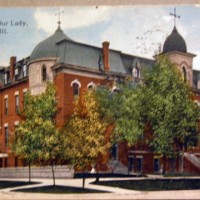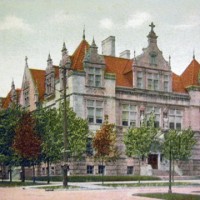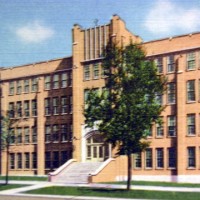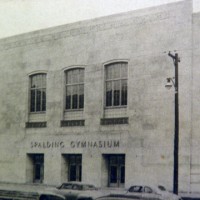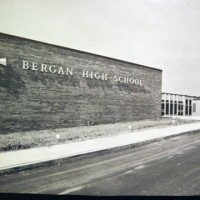Peoria's Catholic High Schools: 150 years of Memories and Tradition
- Details
- Published on Friday, 12 April 2013 17:11
- Written by Dr. Peter Couri
Peoria's Catholic community celebrates 150 years of high school education in 2013.
The pride and tradition established through years has been passed down for four or five generations now. Even if you went to Spalding Institute, the Academy of Our Lady, Bergan High School or Peoria Notre Dame, graduates feel the sense of unity of being fortunate enough to have had the academic opportunities of private education, the network of life-long unshakable friendships, and religious instruction that shaped one's inner peace and morality.
Events to commemorate the 150th birthday begin Monday.
Academy of Our Lady, circa 1870Below is a timeline tracing the history of Catholic high schools in Peoria.
April 19, 1863: Father Abram Ryan, pastor of St. Mary's Church, escorts seven Sisters of the Order of St. Joseph of Carondelet in St. Louis, to Peoria to establish a Catholic school for girls.
Traveling with them was Matthew Henebery, a prominent Peoria whiskey distiller who funded the new school with 11 other men who earned the nickname "the Loyal Sons."
Mother Mary Teresa became the first superior. She supervised the purchase of a two-room frame house on Jefferson Street between Hancock and Bryan.
April 1864: The school was moved to a larger house at 205 N. Madison between Fayette and Hamilton.
September 1870: A large Parisian-style boarding school that could house 100 girls and 16 sisters was built at the corner of Madison and Bryan.
The four-story building cost $35,000. Both Catholic and non-Catholic girls from the very finest families in Peoria attended with tuition being $15.00 a month.
January 1874: The official name of the girl's school became "The Academy of Our Lady of the Sacred Heart." The studies list included English, rhetoric, natural philosophy, literature, geology, government, zoology, mythology, botany, astronomy, mental philosophy, chemistry, French, German, Spanish, music and the arts.
Spalding High School, 1901May 23, 1877: Peorians welcome their newly consecrated bishop, John Lancaster Spalding, with a joyous reception in the study hall of the Academy of Our Lady.
1898 – September 1901: Archbishop John Lancaster Spalding, the first Bishop of Peoria, donated his personal wealth to establish a Catholic high school for boys. He purchased the corner of Jackson and Madison from Alexander and Lucie Tyng, noted Peoria education activists.
Originally called "St. Mary's Academy," public pressure to use the Spalding name mounted. The bishop relented to the name "Spalding Institute" in honor of his late brother, Fr. Ben Spalding.
The final cost of the Flemish Renaissance-style limestone building was over $60,000. Spalding opened its doors in September 1901 to 60 boys and three faculty members.
September 1903: Spalding Institute fields its first football team. The nickname was not "the Fighting Irish" but "the Purple."
June 13, 1929: A new addition to the Academy was dedicated by Bishop Edmund Dunne, the second Bishop of Peoria.
The new building was designed in the more American art deco style with 22 new classrooms, a chapel, offices, library, auditorium, bookstore, and gymnasium. The Sisters were especially proud of the new science laboratories considered the best in the Midwest.
Acadmey of Our Lady addition, 1929April 1947: Construction is completed on 12 large new classrooms and science laboratories built adjacent to the original school. It is named "the Schlarman Annex" after Bishop Joseph H. Schlarman, who provided the funding.
Feb. 8, 1953: Bishop William E. Cousins blessed and presented to Peoria its largest and newest high school gymnasium. The new Spalding gym cost $750,000 and its sleek modern design stood in sharp contrast to the very European-styled main building.
Seating for 3,200 fans meant the massive hardwood basketball floors and modern scoreboards could be enjoyed for years to come. The lower level held the new cafeteria, which doubled as the popular Catholic Youth Center.
September 1957: The Academy erected a new convent on Jackson Avenue. It had two new large classrooms and a popular student lounge.
July 1962: The ground-breaking ceremony was held at Sheridan Road and Glen Avenue for a new, 28-acre northside Peoria Catholic high school.
September 1963: The freshman class "pioneers" of the new Bergan High School were enrolled with other grades being added over the next three years.
The school name honored Gerald T. Bergan, Archbishop of Omaha, the first native-born Peorian to become a bishop.
Spalding Gymnasium, 1953April 5, 1964: Bishop John B. Franz of Peoria led the grand procession to dedicate the new Bergan High School with much fanfare.
The keynote address was given by Archbishop Gerald Bergan, who remembered fondly his days at Spalding Institute and how it shaped his life.
September 1973: The two downtown Peoria schools merged into one administrative and academic unit to become the Academy of Our Lady/Spalding Institute.
June 1980: The section of Madison Street that separated the Academy and Spalding was permanently closed for the safety of the hundreds of students that cross for classes everyday.
Oct. 30, 1987: Bishop Edward O'Rourke celebrated the 125th anniversary of Catholic education in Peoria by dedicating the new Madison Street mall with refurbished walkways, green trees, bushes, and floral beds.
Fr. Raymond Novacek's 1963 "Madonna & Child" sculpture was refurbished and became the central focal point of this urban pocket park.
Bergan High School, now Peoria Notre Dame, 1963March 1988: The Peoria Area Pastors Board, under the leadership of Bishop Edward O'Rourke and Coadjutor Bishop John Myers, made the decision to strengthen Catholic high school education for the future by merging the Academy of Our Lady/Spalding Institute and Bergan High School. The 40-acre north campus was chosen over the downtown facilities.
Students voted for the new school to be named "Peoria Notre Dame."
Feb. 24, 2006: Peoria Notre Dame plays the last game in the old Spalding gym in front of 2,000 fans. Former Peoria Mayor Jim Maloof rallied the crowd with school spirit songs. The building was razed to allow construction of the new Sheen Pastoral Center.
Sept. 28, 2012: Peoria Bishop Daniel R. Jenky led the groundbreaking ceremony for a new Peoria Notre Dame sports complex.
Located on 71.5 acres at Willow Knolls and Allen Road, the new stadium will accommodate football, soccer and track with seating for more than 3,000. Two baseball fields, two softball fields, tennis courts, and practice fields will surround the stadium. The $6.4 million complex is expected to open in 2014.
Future plans on the site include a new high school.















































